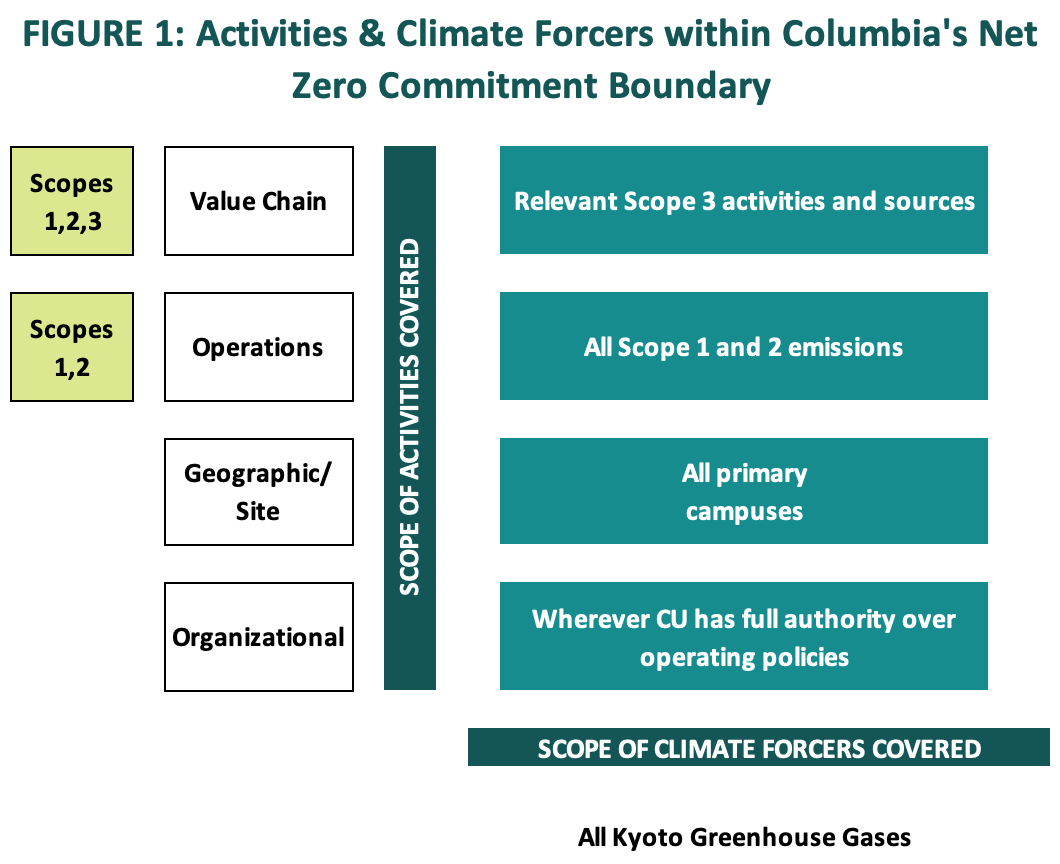Climate Leadership
Columbia commits “…to becoming carbon neutral by 2050, with the hope, and expectation, of arriving at that point even earlier." - President Lee C. Bollinger, January 30, 2020
“The effort to achieve net zero emissions must be sustained over time, employing all the tools available to us and engaging all who are at Columbia today and those who will follow us in the years ahead…[this plan] reaffirms that commitment…” - President Lee C. Bollinger, January 21, 2021
On a path that achieves net zero emissions by 2050.
Climate leadership is, in part, a function of the breadth of emissions-related activities and sources Columbia takes responsibility for, the pace at which emissions abatement occurs, and the nature and quality of Columbia's strategies for mitigation.
In support of President Bollinger’s statement and recognizing the urgency of the climate crisis, Columbia University is joining the global movement of leading organizations in aligning its Sustainability Plan 2030 “with the most ambitious aim of the Paris Agreement, to limit global temperature rise to 1.5°C above pre-industrial levels and reach net zero by 2050 for the best chance of avoiding the worst impacts of climate change.” Source.
With this plan, Columbia University establishes principles for ambitious science-based GHG emission reduction targets (SBT) consistent with this objective. To identify these principles, Columbia has relied on information available from the Science Based Target initiative (SBTi), the Intergovernmental Panel on Climate Change (IPCC), and the UN Environment Programme (UNEP), and has consulted with key faculty members at the Earth Institute.
The resulting principles that will guide Columbia’s science-based targets are as follows.
With respect to the breadth of Columbia's responsibility:
As visualized in Figure 1, our targets will cover:
- All climate forcers (GHGs) required as per the Kyoto Protocol (CO2, CH4, N2O, HFC, PFC, SF6, NF3).
- This is consistent with the definition of net zero emissions and TCR accounting guidance.
- All Columbia organizations over which Columbia has full operational control
- All primary campuses (Baker Field Athletics Complex, Columbia University Irving Medical Center, Lamont-Doherty Earth Observatory, Manhattanville, Morningside, and Nevis Labs)
- All activities within our value chain that result in material GHG emissions (from our own operations as well as key upstream and downstream activities including Columbia’s investments)
Refer to Figure 1 below for a graphic depicting what falls within our commitment boundaries.

With respect to the pace at which Columbia shall proceed:
Columbia will reach a state of net zero emissions no later than 2050 “with the hope, and expectation, of arriving at that point even earlier.”
Columbia will eliminate sources of emissions at a pace consistent with global mitigation pathways that limit global warming to 1.5°C with limited or no overshoot.
(Refer to the Interim Targets and Trajectory to Net Zero Emissions section of the plan for a discussion of how these principles translate to actionable targets.)
With respect to the quality of Columbia's mitigation initiatives:
The University will follow a mitigation hierarchy that prioritizes eliminating sources of emissions within its value chain (avoid, reduce, and replace) over “compensation” (offsets) and “neutralization” (sequestration/emissions removal) measures. (Refer to Campus Energy and Sustainable Transportation sections for more detail.)
The administration will steer Columbia’s investments to areas that support a sustainable future and have a positive impact on the environment. To this end, Columbia does not hold and will not make new investments in oil and gas companies.
Prior to reaching net zero emissions, the University will consider undertaking efforts to compensate (offset) unabated emissions in order to meet our interim science-based targets.
However, to finally reach net zero emissions, Columbia will apply emission neutralization (not compensation) measures to achieve an amount of emissions removal equal to Columbia’s “residual” GHG emissions, i.e. emissions that could not otherwise be abated.
These compensation and neutralization initiatives will ensure additionality and permanence, address leakage, avoid double-counting, and have a strategic connection to Columbia’s mission.
Columbia’s mitigation strategies will adhere to environmental and social safeguards with explicit consideration, for example, of United Nations Sustainable Development Goals (SDGs).
The University will leverage its approach to science-based targets to strengthen partnerships with global universities committed to climate leadership.
